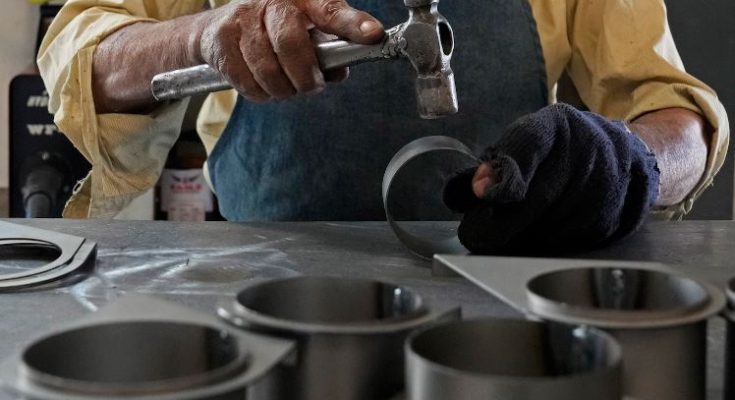Red tape, restrictive import policies and unpredictable regulations have prevented global companies from committing to India, executives and officials say.
NEW DELHI — When companies began shifting their global supply chains away from China, India declared it was ready to become the world’s factory. But the moment hasn’t arrived.
A decade ago, India positioned itself as the prime destination for companies looking to diversify their manufacturing base, known as the China Plus One strategy. Now it is grappling with a sobering reality: Smaller countries like Vietnam have been much more successful at attracting foreign investment.
Bureaucratic red tape, restrictive import policies and unpredictable regulations have prevented global companies from fully committing to India, according to interviews with more than two dozen business executives, government officials and diplomats. Many spoke on the condition of anonymity to discuss sensitive economic matters.
“Things are becoming better, but let’s face it,” said a former Indian ambassador, “we aren’t Vietnam.”
Often obscured by the flashy messaging of Prime Minister Narendra Modi’s signature “Make in India” campaign is a more complicated story — one of missed deals, stalled investments and companies quietly choosing to go elsewhere.
Several Taiwanese semiconductor firms conducted site visits in India but ultimately opted out. Samsung said in 2018 that India would be home to its largest factory in Asia, but the company continues to invest more heavily in Vietnam. Even Apple, India’s most high-profile success story, has faced obstacles that have slowed its planned pivot away from China.
“We feel we have a big market and we feel that we deserve these brands,” said Faisal Kawoosa, an Indian market analyst. “But everybody competes. And Vietnam is doing that extra bit.”
A tale of two countries — and two companies
As manufacturers began to rethink their dependency on China, two industry giants took divergent paths. South Korea’s Samsung — which began making televisions in India in the 1990s — doubled down on Vietnam for its next phase of expansion. Apple, meanwhile, turned its attention to India.
Today, the majority of Samsung’s smartphones are produced in Vietnam. The company has six factories there and investments surpassing $23 billion, allowing it to shut down its Chinese manufacturing operations.
Apple, by contrast, still makes the majority of its devices in China. Only 15 percent are produced in India, well short of the company’s goal of 25 percent by 2024, according to a person close to Apple.
“In Apple’s world, a 15 percent shift is not a lot,” the person said. “It’s not a pace they like.”
Apple and Samsung declined to comment for this story.
India’s sprawling democracy and decentralized governance leads to “inconsistency,” the markets director said. “It is the antithesis of what businesses are looking for.”
Vietnam’s close ties to China give it an edge over India, analysts say, and make it a natural next stop for companies looking to pivot. India, by contrast, severely curtailed Chinese investment following clashes along the countries’ shared border in 2020.
Vietnam’s electronics industry is now worth $126 billion, more than triple the size of India’s — a country 10 times larger and 14 times as populous.
The disparity is borne out by trade figures. Vietnam is now America’s sixth-largest trading partner, ascending from 15th in 2014. India remains stuck in 10th place. A Goldman Sachs report this year found that India’s exports to the United States are among the lowest of any emerging economy.
India’s uphill battle
The urgency for India is mounting amid a slowdown in its economic momentum. The country is in the midst of an acute employment crisis, unable to create enough jobs for the 14 million people entering the workforce each year.
Lagging foreign investment in manufacturing — the kind of labor-intensive industry India needs to develop — is central to the problem.
Even some government assessments acknowledge the reality: “India has seen limited success so far in capturing the China Plus One strategy,” a December report by the state policy planning body concluded. It noted that Southeast Asian nations have drawn more investment, thanks to lower labor costs, streamlined regulations and favorable tax policies.
“The government is aware that we are not the only game in town,” said S. Krishnan, the secretary of India’s technology ministry.
A 2023 parliamentary report found that India had “not been able to create a positive impression amongst the businesses moving away from China.”
“Our disadvantage really is largely policy,” said Arvind Panagariya, chairman of India’s Finance Commission, in a December speech reported by the Indian Express. “We have made land incredibly expensive [and] employment of labor incredibly difficult.”
Missed opportunities
The Indian government has repeatedly urged Taiwanese semiconductor companies to set up shop in Gujarat — Prime Minister Narendra Modi’s home state — but most of those efforts have faltered.
“Due to tariffs, India has failed to attract more Taiwanese investment,” said a senior official with knowledge of the efforts. A lot of companies “came to India for surveys during the pandemic and decided not to come back because it’s not profitable.”
Powerchip Semiconductor Manufacturing Corporation (PSMC) ruled out plans for a joint venture company with India’s Tata Group after assessing the risk, opting instead to sell its technology and assist in factory construction with the Indian conglomerate, the senior official said. A $19.5 billion semiconductor partnership between Foxconn and Indian conglomerate Vedanta collapsed in 2023.
Vedanta and PSMC did not respond to a request for comment.
Companies have “stars in their eyes” looking at India’s market but then begin to calculate the “frictional cost of doing business in India,” said the global markets director.
The hesitation isn’t limited to the production of semiconductors. Out of every ten Japanese companies that inquire about India, only one commits, according to Kenji Sugino, secretary general of Japan’s Chamber of Commerce in India. Only about 10 Japanese companies in total have managed to shift their operations from China to India, Sugino added.
Those that do come often struggle. Japanese auto companies complain of high import duties on friction-free tires. Nippon Steel endured significant losses after Indian customs blocked key shipments for months because of regulatory issues.
For multinationals looking to India, history offers no shortage of cautionary tales.
Pharmaceutical giant Daiichi Sankyo suffered a costly exit from the country in 2013 after American authorities found the Indian company it acquired had falsified data and sold banned exports to the United States, according to an Indian executive with knowledge of the situation.
General Motors, meanwhile, spent at least four years beginning in 2020 trying to sell its Indian factory, hindered by rules requiring the new buyer to retain its workforce, a person familiar with the incident said.
The Indian government is considering fresh incentives to lure foreign companies, including subsidies for component manufacturing. It is also hoping to seal a trade deal with the Trump administration, which would likely to reduce India’s tariffs and make manufacturing in the country more attractive.
“The world needs a trustworthy partner that can create high-quality products and has a reliable supply,” Modi said this month. “I want us to fulfill the world’s expectations.”





